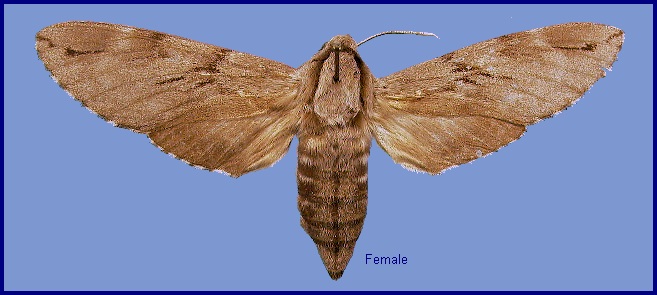
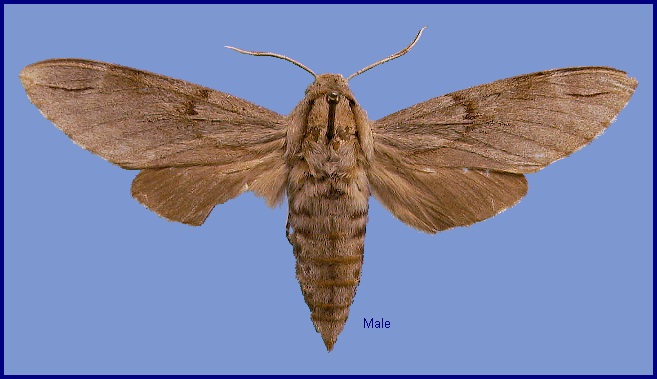
Hyloicus caligineus sinicus Rothschild & Jordan, 1903, Novit. zool. 9 (suppl.): 149. Type locality: China, [Zhejiang,] Zocé [Sheshan, 31°10'N 121°19'E].
Synonym. Sphinx caligineus sinicus (Rothschild & Jordan, 1903).
Note. Mell (1922a) described brown specimens of what he took to be Hyloicus caligineus from northern Yunnan as Hyloicus caligineus brunnescens, a subspecies that he claimed was confined to montane forests. Later, however, he also referred specimens from northern Guangdong and southern Hunan to this subspecies (Mell, 1922b) and stated that Hyloicus caligineus brunnescens was intermediate ('ein Mittelglied') between the dark brown Hyloicus caligineus caligineus Butler, 1877 from Japan and the paler grey Hyloicus caligineus sinicus from 'Zocé' (= Sheshan), Zhejiang. On 30.vi.1995, the first author captured a specimen of Hyloicus caligineus at Hangzhou (Zhejiang) that was transitional in colour between Hyloicus caligineus sinicus and Hyloicus caligineus brunnescens. In addition, there is a brown female in the IZAS from nearby Sheshan (Zhejiang) (the type locality of Hyloicus caligineus sinicus) that matches the description of Hyloicus caligineus brunnescens, while grey specimens of what appear to be Hyloicus caligineus have been captured at 2250m in northern Yunnan (Pittaway & Kitching, 2000). We therefore initially considered it likely that Hyloicus caligineus brunnescens was simply a colour form of Hyloicus caligineus sinicus, analogous to the brown forms that exist in the European species, Hyloicus pinastri (Linnaeus) (Pittaway & Kitching, 2000).
However, with the description of Hyloicus yunnana (Brechlin, 2015) (from Yunnan), and Hyloicus centrovietnama (Brechlin, 2015) (from Vietnam), the situation with regard to the nomenclature and distribution of Hyloicus yunnana, Hyloicus centrovietnama, Hyloicus caligineus sinicus and Hyloicus caligineus brunnescens became even more confusing. The grey specimens of Hyloicus caligineus mentioned above, which were captured at 2250m in northern Yunnan, have been confirmed as being Hyloicus yunnana. In fact, all individuals of Hyloicus caligineus sinicus from Yunnan and Sichuan mentioned in Pittaway & Kitching (2000) are Hyloicus yunnana. As no individuals of Hyloicus caligineus have ever been confirmed from Yunnan and Sichuan, the brown individuals that Mell (1922a) described from northern Yunnan appear to be the brown form of Hyloicus yunnana. Using DNA barcodes, the Hyloicus caligineus brunnescens-like individuals recorded from NE Laos have been confirmed as being Hyloicus centrovietnama (Ian Kitching, pers. comm. 2018), a species which extends northwards into southeastern China.
No type material of Hyloicus caligineus brunnescens could be found in CMNH or MNHU; specimens labelled 'type' in CMNH or 'paratype' in MNHU do not have appropriate data. They appear to be the specimens referred to by Mell, 1922, Beitr. Fauna Sinica 2 (Biol. Syst. südchin. Sphingiden): 52-57, that he reared in Guangdong and Hunan Provinces. However, in the section titled "Resting place" Mell, 1922, Beitr. Fauna Sinica 2 (Biol. Syst. südchin. Sphingiden): 56, did refer to a wild-caught female found on a dry path in the foothills of Yunnan that may be interpretable as a type, but its present whereabouts remains unknown. Danner, Eitschberger & Surholt, 1998, Herbipoliana 4(1): 58, erronously gave the type-locality as 'Bergwälder im Norden der provinz Kuangtung'. However, Zolotuhin & Yevdoshenko (2019) finally correctly established Hyloicus yunnana as a junior synonym of Hyloicus brunnescens based on DNA barcode analysis of both greyish and brownish specimens, and study of male genital morphology. This taxonomy is accepted here.
There is also another complication in that there are enough differences in coloration and patterning between the larvae of Hyloicus caligineus sinicus and Hyloicus caligineus caligineus to indicate that they may be distinct species and not just subspecies.
Wingspan: 55--76mm. Differs from Hyloicus caligineus caligineus in having: body and wings paler, more grey-brown; hindwing with veins Rs and M1 shorter stalked; antenna with scaling white, with a few brown scales on the middle segments; mesothoracic tegulae with brown borders faint, vestigial in the female; forewing upperside with discal streaks faint or absent.
Male genitalia similar to Hyloicus caligineus caligineus, but gnathos less obviously sinuate, the lobes much shorter; valve shorter, more rounded apically; harpe with processes shorter, the dorsal one not curved dorsad apically, the ventral one much narrower; phallus with apical lobe much shorter even than in Hyloicus pinastri, more similar to that of Hyloicus oberthueri. In the female genitalia, ostial plate with lobe more deeply sinuate than in Hyloicus caligineus caligineus.
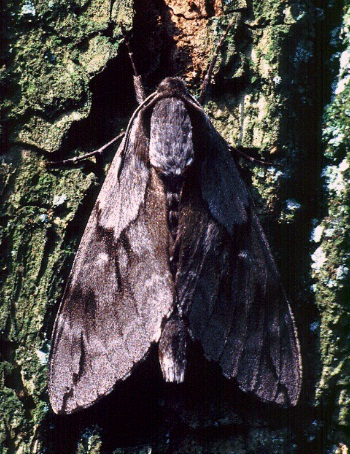
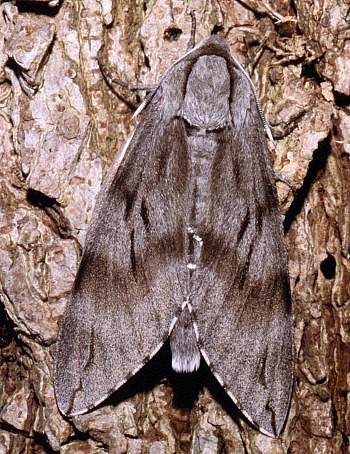
Common in hilly areas with a good density of pines (Pinus species).
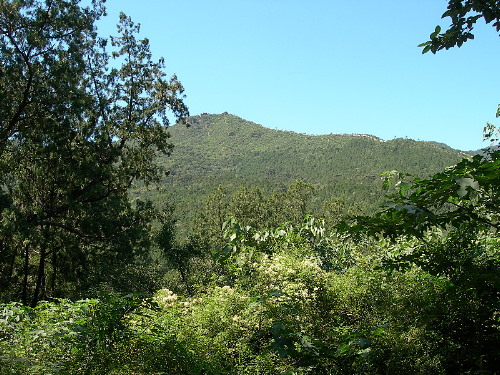
China: iv (Ningbo; Baihua Shan, Beijing); v (Tianjin; Hebei; Beijing); 7.v (Xingshan); 9-13.v (Beijing); 11.vi (Shaanxi); 21-27.vi (Beijing); 30.vi (Hangzhou); 19.vii (Shaanxi); vii (Shandong; Nanjing). North Korea: 15-29.v (North Pyongan Province); 1-12.vii (North Pyongan Province). South Korea: vii ([unspecified locality]).
Two generations a year, with adults flying in (April)/May/June and July-September (Yang, 1978).
Park et al. (1999) gives July for Korea.
OVUM: Oval (2.13 x 3.09mm). Very large for the size of moth.
LARVA: Full-fed 47--50mm. Generally found about 2.0-2.5m off the ground among the needles of terminal shoots, where full-grown larvae are extremely well camouflaged if resting along a twig.
Full-fed larvae are always grey-brown, which is in distinct contrast to the larva of Hyloicus caligineus caligineus Butler, 1877, which is always green and brown with white longitudinal stripes, indicating that the two taxa may be distinct species and not subspecies.
Larvae of this species produce an extraordinary amount of frass for the amount of vegetable matter they eat. Often, two or more of the frass pellets may be stuck together.
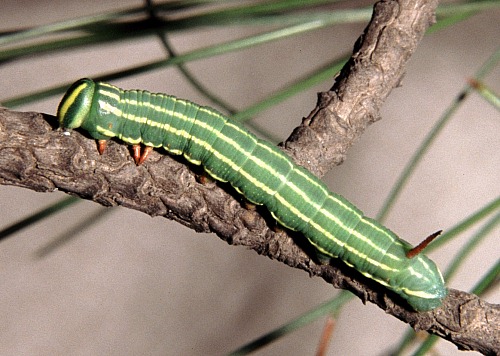
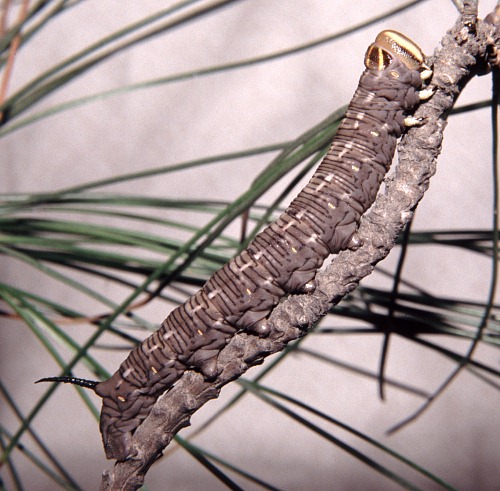
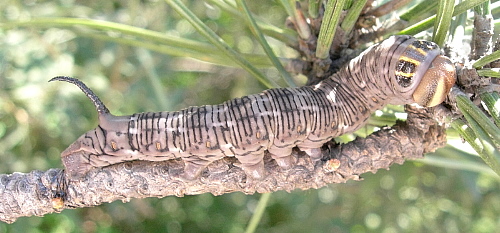
PUPA: 28--40mm. Dark mahogany brown and glossy, with even darker wing cases and thorax. Head projecting frontad, eyes slightly bulbous, with no free tongue-case as found in related members of the genus. Tongue-case flush with the legs and reaching to the wing tips. Whole pupa finely punctate. Spiracular ridges present on movable abdominal segments. Cremaster triangular to almost conical, narrow, with a double sharp point; tuberculate. Similar to that of Callambulyx tatarinovii. Formed in an almost silk-free cell in the soil. The overwintering stage.
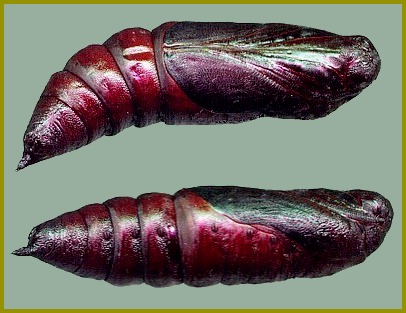
Larval hostplants. Mainly on Pinus tabulaeformis to the west and north of Beijing (Zhu & Wang, 1997; Pittaway, pers. obs. 2003), as well as the ornamental Pinus armandii (Pittaway, pers. obs. 2003). In Guangdong, Mell (1922b) recorded Hyloicus caligineus brunnescens on the native pine, Pinus massoniana, but this record is now known to be of Hyloicus centrovietnama. Other native hostplants of Hyloicus caligineus in China are unknown but Wang (1992) listed the introduced pines Pinus elliottii and Pinus taeda for Hunan. The record on Betula (Wang, 1992) is certainly erroneous.
Unknown.
China: Hebei (Chengde); Beijing (Xiangshan; Botanical Garden; Baihua Shan; Puwa, 1100m; Haidian); Tianjin; Shandong; Shaanxi (Yangling; Tongchuan; Huyi, Qinling); Jiangsu (Nanjing); Anhui (Mt. Huang Shan); Shanghai; Zhejiang (Hangzhou; Ningbo; Sheshan); Hubei (Xingshan, 1300m); Hunan (Luoxiao Shan).
Records in the Chinese literature from southeastern Xizang/Tibet (Mutu, Namjagbarwa region, 850m) (e.g. Zhang et al., 1986, pl. 1, fig. 3) are usually misidentifications of Hyloicus oberthueri; however, there is the possibility that they could be of the newly described Hyloicus bhutana (Brechlin, 2015), or Hyloicus brunnescens (Mell, 1922).
North Korea: North Pyongan Province (Chonma County, Chonma-san).
South Korea: Kangwon Province (Seolak-san); South Cholla Province (Baekyang Temple).
Northeastern and eastern China, as well as North Korea and South Korea.
Older records from northern Thailand (Inoue et al, [1996]) and Vietnam refer to what is now Hyloicus centrovietnama (Brechlin, 2015), a species which extends north into southeastern China (as far as Hangzhou), where it has been confused with Hyloicus caligineus and Hyloicus brunnescens.
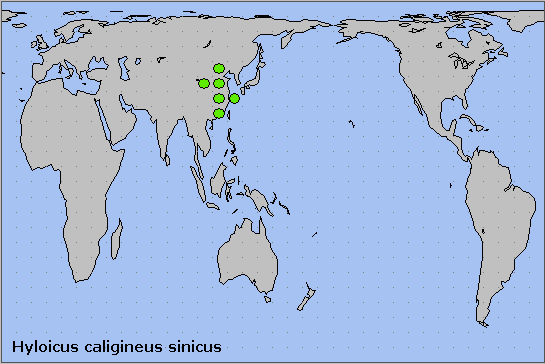
Holarctic; eastern Palaearctic region. Pleistocene refuge: Monocentric -- Sinopacific refugium.
 Return to Sphingidae of the Eastern Palaearctic species list
Return to Sphingidae of the Eastern Palaearctic species list